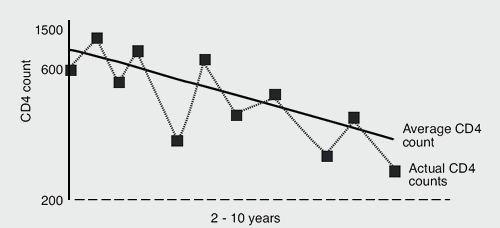
1. 9 Interpreting CD4 results: CD4 count and CD4 percentage
A CD4 count is the number of CD4 cells in a cubic millimetre (cells/mm3) of blood.
This is sometimes written as cells per microlitre (cells/µL) or as cells x 106/L. Information about units of measure for blood tests.
A CD4 count is sometimes called an absolute CD4 count. This is because it counts the actual number of cells in a blood sample.
- A CD4 count above 500 is considered “normal”.
- In high-income countries, a CD4 count below 350 is defined as late diagnosis or advanced HIV. It shows HIV has damaged your immune system.
- In high income countries, a CD4 count less than 200 is defined as very late diagnosis or very advanced HIV. This is linked to a much higher risk of serious infections.
- WHO guidelines (for low- and middle income countries) define a CD4 count less than 200 as advanced HIV disease (AHD).
But a single CD4 count doesn’t tell you very much. You really need to get several results over time to see a trend. This is now rarely done because most people start HIV treatment (ART) soon after they are diagnosed.
CD4 counts fluctuate. They go up and down during the day. For example, CD4 counts are lower when you first wake up and higher later in the day. [1]
They are higher immediately after exercise – even after going up and down stairs. They can also be affected by whether you recently ate a meal and whether you have other infections. Or even if there were just more or fewer cells in that sample of blood.
None of these variations mean that your immune system is stronger or weaker.
This is why the trend of CD4 results is more important than any single count. The trend looks at the average of several results over time.
Several results show whether the trend is going up or down. Also whether it is stable or changing. But in 2023, most people just start ART rather than waiting to see a trend.
CD4 count trend without ART
Without ART, the average CD4 count will generally be going down.
This is why it is better to be diagnosed early.

Each point on the dotted line shows an individual (absolute) CD4 count without ART. For example, in someone who has not yet been diagnosed.
The solid line shows the average of these results. This shows that the CD4 count falls over time. Even though the absolute number will sometimes be higher, the trend over time is more important.
ART should make the trend increase over time. Sometimes the absolute CD4 count can be lower than the previous result. So long as viral load is still undetectable your meds are still working well.
Once someone is on effective ART, the CD4 count might only be tested once or twice a year. Once on ART, the most important monitoring test is viral load. (See Section 2).
CD4 percentage (CD4%)
The CD4 percentage (CD4%) is the percentage of white blood cells (lymphocytes) that are CD4 cells.
The immune system contains lots of different cells. The two main types of lymphocytes are T cells and B cells. CD4 cells are a type of T cell. So the CD4% looks at the CD4 count in relation to other immune cells.
CD4% is sometimes a more stable indication of whether there has been a change in the immune system. If the percentage hasn’t changed, any changes in the absolute count are not important.
- A CD4% of 12-15% is about the same as a count of 200-350 cells/mm3.
- A CD4% of 29% is about the same as a count of over 500 cells/mm3, but there is a wider range for higher values.
- The average normal CD4 percentage for someone who is HIV negative is about 40%. The normal range is anywhere from about 25% to 65%.
The CD4% count is used to monitor children under 12 years old. This is because babies are born with very high CD4 levels. A baby can have a CD4 count that is 3000 cells/mm3.
References
- Carmichael KF et al. Analysis of diurnal variation of lymphocyte subsets in healthy subjects in the Caribbean, and its implication in HIV monitoring and treatment. Afr J Med Med Sci. 2006 Mar;35(1):53-7.
https://www.ncbi.nlm.nih.gov/pubmed/17209328
Last updated: 1 January 2023.
